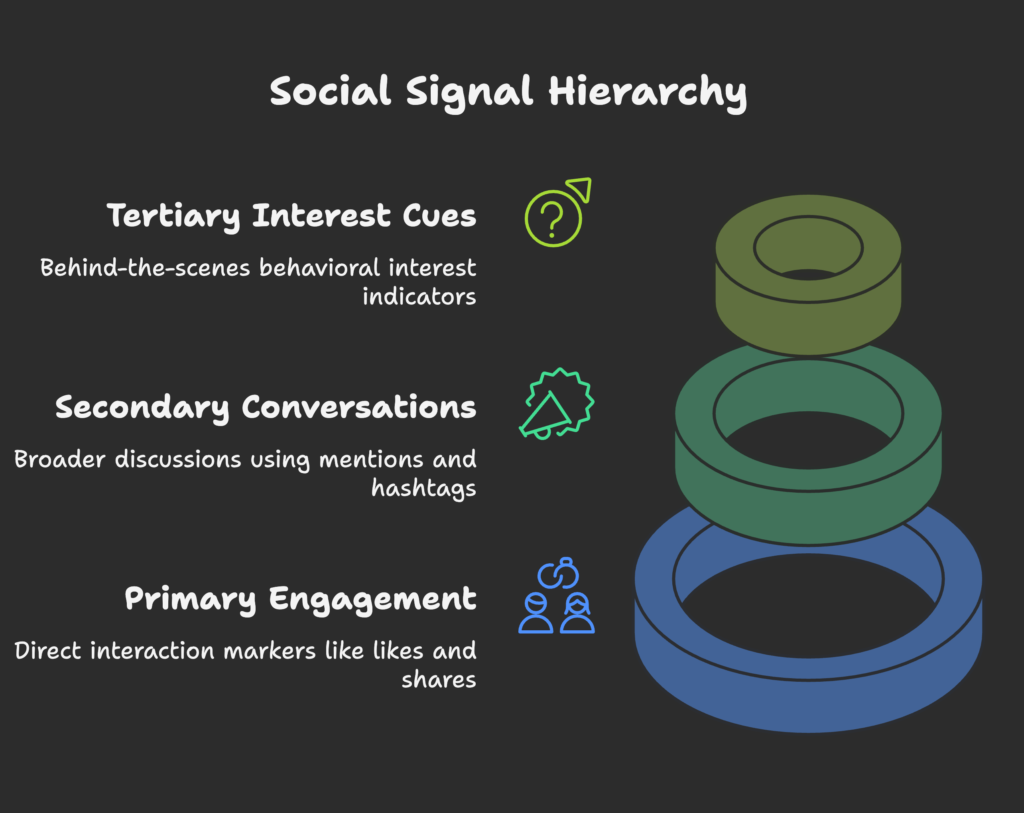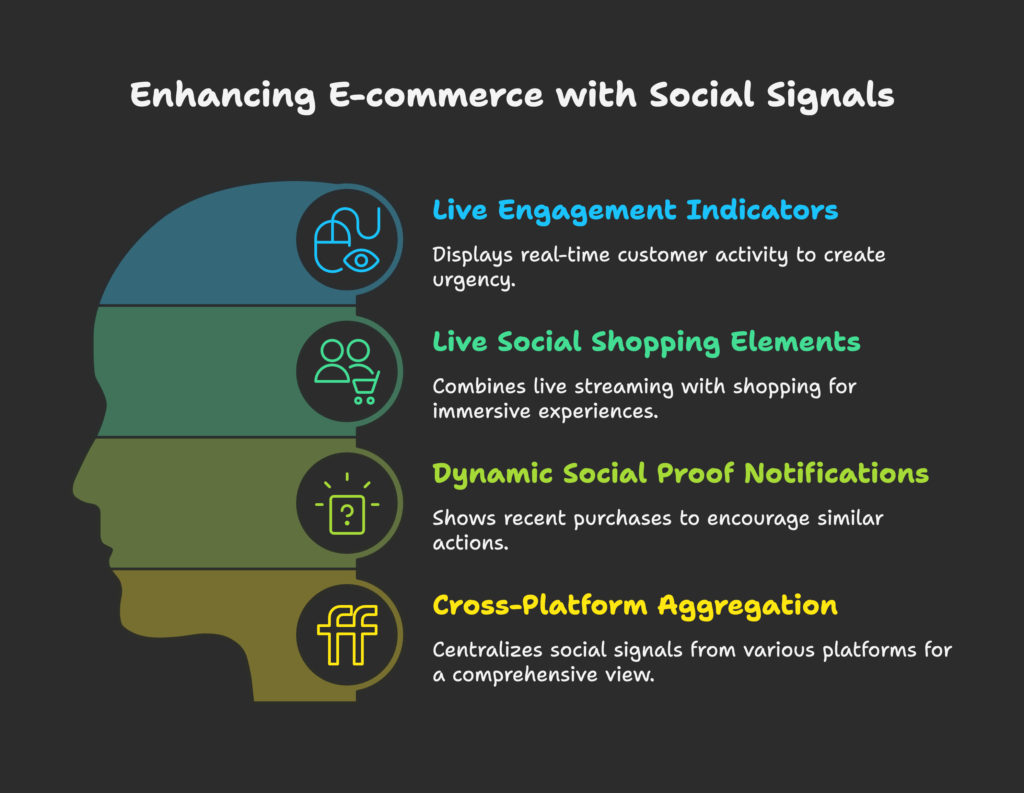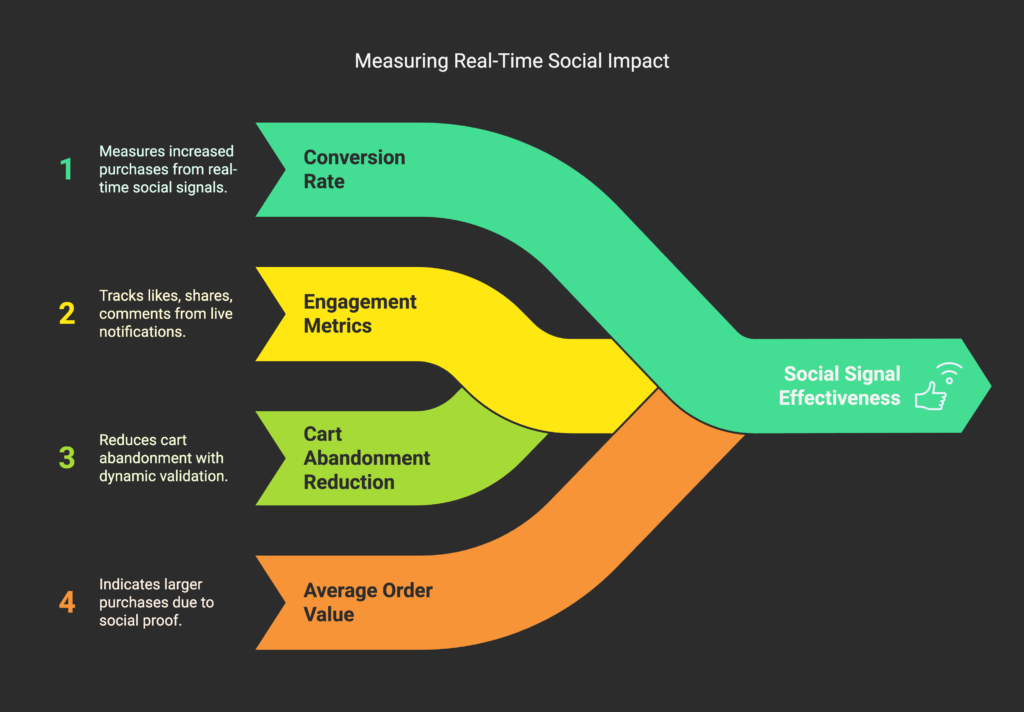Have you ever felt a rush of confidence when you see that countless other people have bought or loved a product you’re looking at? That powerful feeling is called social proof. In this introduction, we’ll explore how social proof has evolved from simple star ratings and comments to real-time signals that feel more authentic, immediate, and exciting. By reading this section, you’ll learn about traditional social proof, why it matters, and what led us toward more dynamic, “live” social validation. Ready to discover the first steps of this fascinating shift? Let’s go!
Defining Traditional Social Proof
Traditional social proof began as a psychological principle indicating that people tend to copy the actions of the majority. For years, online stores have leaned on reviews, testimonials, and ratings to persuade new shoppers. Early studies showed that websites showcasing customer feedback often saw higher sales. This is rooted in Dr. Robert Cialdini’s classic framework of influence, which emphasizes our need to act in ways that reflect the behavior of others. In the early days of e-commerce, these mechanisms worked wonders because they offered a quick path to trust.
But don’t get too comfortable—there’s more to this story. Let’s see why we’ve shifted beyond these static methods.
The Shift from Static to Dynamic Social Evidence
Although star ratings and testimonials remain valuable, shoppers increasingly crave fresh and genuine updates. A year-old review might not feel relevant anymore. Today, consumers demand proof that is immediate and harder to fake—what we call Social Proof 2.0. Thanks to technology, we can now share real-time signals like live visitor counts or up-to-the-minute sales notifications. This shift caters to our desire for authenticity and “live” validation, making online shopping feel more like an engaging conversation than a static catalog.
Now that you see why the world wants more active forms of validation, let’s look at how businesses can benefit from upgrading to these advanced social signals.
The Business Value of Advanced Social Signals
Brands that adopt real-time social signals often notice higher conversion rates. Imagine a popup that says “Emily from London just purchased these shoes!”—it adds a sense of excitement. Studies repeatedly show that displaying real-time engagement can create urgency (“People are buying now!”) and elevate trust. It’s also a great way to stand out from competitors who still rely solely on static reviews. This enriched experience keeps customers engaged and willing to explore more of what you offer.
Ready to dig deeper into what these signals really are and how they influence trust? Let’s jump to the next section for a more detailed look at social signals in the digital ecosystem!
Understanding Social Signals in the Digital Ecosystem
How do we define social signals, and why are they considered the new currency of online interaction? In this section, we’ll define social signals, categorize them, and reveal how they build trust among potential customers. By the end, you’ll understand the many forms these signals can take—and how each form can shape your brand’s credibility. Curious? Let’s explore!
Defining Social Signals in Modern E-commerce
In simple terms, social signals are the echoes of human interaction on the internet. These can be anything from likes, shares, and comments to more subtle indicators, such as people adding items to their carts. Over time, we’ve moved from only counting likes or follows to measuring broader engagement like video watch time or brand mentions. Direct social signals happen when people actively interact with your brand (e.g., commenting on a post), while indirect signals arise through discussions or shares that happen in communities outside your immediate channels.
This wide range of metrics gives a more accurate picture of how people feel about your brand, giving you the chance to respond in real time and shape their experience more effectively.
The Social Signal Spectrum

We can break social signals into three layers:
- Primary signals: Likes, shares, comments, and similar engagement markers.
- Secondary signals: Mentions, hashtags, and the broader conversations around your brand.
- Tertiary signals: Behavioral cues like time-on-page or frequent cart additions, which happen behind the scenes but reveal high interest.
All these signals combine to form a rich backdrop of how customers feel about your business. The more signals you have, the stronger your credibility can appear to new visitors—assuming they are genuine and easy to spot.
But social signals don’t just make you look good; they are powerful trust builders. Let’s see how they become real drivers of confidence in your brand.
Social Signals as Trust Indicators
When people see an active community around your products, they get the feeling of joining something popular or worthwhile. It’s the digital version of positive word-of-mouth. The visible presence of engaged followers or active discussions can significantly enhance your reputation. Generally, the more immediate and authentic these signals look, the higher the trust they inspire. Consumers can sense authenticity, so genuine engagement almost always beats inflated numbers.
Now that we’ve uncovered why social signals matter, let’s explore how real-time information supercharges these signals in the next part!
The Real-Time Revolution in Social Proof
In this section, you’ll discover what happens when social proof gets faster, fresher, and more immediate. Real-time validation not only creates a sense of urgency but also makes the entire shopping journey feel more alive. Stick with us, and you’ll see how this new approach can drastically elevate your marketing efforts!
From Static to Dynamic: The Real-Time Advantage
Real-time social signals involve any live updates that show customers exactly what’s happening with your brand right now. For example, a running counter of how many people are currently viewing a product can trigger a sense of excitement or scarcity (“If I wait, it might sell out!”). This immediacy boosts engagement because it aligns with our natural preference for current information over outdated data. Static proof (“100 reviews in total”) is good, but dynamic proof (“15 shoppers looking at this product right now”) triggers stronger emotional reactions.
Feeling the adrenaline rush of real-time signals? Keep going, because we’re about to dive into how real-time marketing and social proof unite for even bigger impact.
Real-Time Marketing and Social Proof Integration
Real-time marketing focuses on capturing the moment as events unfold. Pairing this strategy with social proof supercharges your promotions. For instance, responding quickly to comments about a flash sale can build trust and increase participation. This speed shows customers you’re engaged, which can make your brand memorable. Studies even suggest that brands utilizing real-time tactics see an uptick in sales and brand loyalty compared to those sticking with slower, scheduled posts.
But how do you actually handle all this data in real time? Let’s pull back the curtain on the technology that makes it possible.
The Technology Enabling Real-Time Social Proof
Behind the scenes, advanced data systems collect and process vast amounts of user activity. APIs let businesses integrate live social data directly into their websites or apps. Meanwhile, real-time analytics platforms offer dashboards showing current engagement metrics, helping you update your website on the fly. Even edge computing—processing data closer to where it originates—cuts down on delays, so users see up-to-the-moment signals with minimal lag. This tech infrastructure is why a “live feed” of purchases or interactions doesn’t crash your site.
Excited to see how you can harness these tools in concrete ways? Let’s look at the different types of real-time social signals that can add magic to your e-commerce store.
Types of Real-Time Social Signals for E-commerce
Which real-time signals should you focus on first? In this section, we’ll walk through the most popular types—from live engagement counters to social shopping broadcasts. After reading this, you’ll have a clearer idea of which signals match your brand’s style and how each one can boost trust and sales.

Live Engagement Indicators
Live engagement indicators show immediate activity, such as how many people are viewing a product or adding it to their carts. They can also include rolling updates of new customer sign-ups or purchases. Some stores even display a running chat or Q&A section that lets shoppers ask questions on the spot. These features create a sense of community and urgency that can spur faster buying decisions.
Next, let’s push the concept of “live” even further with social shopping that takes place in real-time streams.
Live Social Shopping Elements
Live social shopping is like a blend of a TV infomercial and a group chat, but you get to buy the product directly in that moment. Brands may host live streams on platforms where the audience can vote on which products to showcase or ask questions that get answered immediately. It’s an immersive experience that can drive higher conversion rates because it makes online shopping feel exciting and personal. Recent data shows that live shopping experiences have led to spikes in sales for beauty, fashion, and tech brands.
But real-time updates can also come in smaller, simpler forms. Let’s see how dynamic social proof notifications can keep your customers in the loop.
Dynamic Social Proof Notifications
Ever see a little pop-up at the corner of a website saying, “Amy from Chicago just bought this product”? Those are dynamic social proof notifications. They typically show the most recent purchases or sign-ups as they happen. Some systems even tailor these notifications based on location or browsing behavior, making them feel highly relevant. By tapping into the user’s personal context (“Someone near you just bought this!”), your store can evoke curiosity and nudge visitors to follow suit.
But what if your brand is active on many different platforms? The next sub-section shows how to unify signals coming from multiple channels.
Cross-Platform Social Signal Aggregation
Cross-platform aggregation tools collect signals from various social media networks, forums, and marketplaces, then compile them into a centralized display. This might mean pulling your latest positive review from Amazon, your newest Instagram comment, and your trending hashtag on TikTok, all shown together. These combined signals can offer a “big picture” of just how popular and trusted your brand is across different channels.
Ready to take your new knowledge about signal types and turn it into an actionable plan? Let’s move on to implementing real-time social signals in your own store!
Implementing Real-Time Social Signals in E-commerce
In this section, you’ll learn practical ways to incorporate real-time social proof into your website or app. We’ll dive into the tech you need, how to design the user experience, and how to generate the kind of content that fuels these signals. By the end, you’ll be well-equipped to launch your own Social Proof 2.0 strategy. Let’s get started!
Technical Implementation Strategies
To handle real-time data, you’ll need a robust backend that can capture and process social interactions quickly. Consider using data streaming architectures like Kafka or cloud-based services that specialize in live analytics. Integrate APIs from major social networks to pull real-time engagement stats. Performance optimization is crucial: if your site lags, it undercuts the excitement you’re trying to build with live updates. Make sure your hosting environment can handle sudden spikes in traffic whenever social proofs are displayed.
Now that you know the basic tech, let’s see how to present these signals in a way that delights (and doesn’t overwhelm) your customers.
User Experience Design for Social Signal Display
Design plays a key role in how effective your signals will be. Real-time counters should be visible but not intrusive. Bold alerts can grab attention, but too many can annoy shoppers. Placing notifications in the lower corners of the screen often strikes a good balance. For mobile, make sure pop-ups adapt to smaller screens and don’t interfere with the main shopping flow. Using A/B testing can help you pinpoint which layout, timing, and frequency of notifications work best for your audience.
Once you have the technical and design layers ready, it’s time to spark the community engagement that generates these signals in the first place.
Content Strategy for Generating Quality Signals
High-quality content encourages meaningful engagement. Share product stories, behind-the-scenes glimpses, and tips that spark discussions. Ask open-ended questions to invite comments and sharing. Start or participate in online communities where your product resonates. The key is to motivate users to post, like, and engage because that’s what triggers the social signals you want to showcase. User-generated content, such as images or videos of people actually using your products, can supercharge trust and authenticity.
But not all platforms work the same way. Let’s see how to tailor your approach to different social sites.
Platform-Specific Implementation Approaches
- Facebook & Instagram: Integrate real-time shopping features like live streams and instant cart options. Encourage short, snappy comments and shares.
- Twitter: Make use of trending hashtags and retweets for quick bursts of visibility.
- TikTok: Use live video streams to showcase products with fun, creative content. Respond to comments fast to maintain the “live” feel.
- Marketplaces (Amazon, eBay): Optimize listings so new reviews or Q&A show up instantly, boosting trust for potential buyers.
Each platform has its own culture and tools. A tailored approach ensures you’re maximizing your real-time signals in the most relevant way.
Now that you’ve mastered the “how,” let’s measure the impact. Ready to see the tangible results of real-time social signals? Let’s move on!
Measuring the Impact of Real-Time Social Signals
This section is all about numbers and analysis. You’ll learn which metrics matter the most and how to build an analytics framework to evaluate your social proof efforts. If you’re excited to see how these signals directly affect your bottom line, you’re in the right place!
Key Performance Indicators for Social Signal Effectiveness

The core indicators to watch include:
- Conversion Rate: Whether shoppers buy more often when shown real-time signals.
- Engagement Metrics: Likes, shares, and comments that result from your live notifications or streams.
- Cart Abandonment Reduction: Fewer people leaving their carts behind after seeing dynamic validation.
- Average Order Value (AOV): Any uptick in purchase size driven by social proof elements.
Tracking these metrics over time can reveal the true impact of your real-time social strategies.
Next, we’ll delve into specific tools and methods to collect and interpret this data.
Analytics Frameworks for Signal Evaluation
Many real-time social analytics platforms—often equipped with dashboards—provide immediate insights into how your audiences respond. You can also integrate social signal events into tools like Google Analytics or other tracking software. Create custom dashboards that display engagement levels next to sales outcomes, so you know exactly how each type of signal affects revenue. Combining these stats with qualitative data, such as customer feedback, can paint a full picture of your real-time social proof effectiveness.
But what about the bottom line? Let’s take a quick look at ROI and see how to quantify your success.
ROI Calculation Methodologies
To calculate return on investment, factor in both the setup costs (technical tools, manpower) and the gains (increased sales, improved brand reputation). Attribution models can help you see which part of a sale is driven by real-time signals. Over time, you can track whether higher engagement translates into long-term customer loyalty, revealing a bigger picture of how these signals contribute to lifetime value. Gaining a competitive edge in your market also translates into indirect benefits that are harder to measure but equally vital.
Enough theory—want some real-world inspiration? Let’s jump into case studies from different industries to see these principles in action.
Case Studies and Real-World Applications
If you’re looking for proof that real-time social signals drive results, this section is for you. We’ll explore examples from retailers, service providers, and even sectors like entertainment or healthcare. By the end, you’ll see how these practices can work for businesses big and small.
Retail and E-commerce Success Stories
Consider Lady Gaga’s Haus Labs makeup brand, which used live shopping events to achieve a massive boost in sales—sometimes up to 10 times higher during those broadcasts. Smaller boutiques have also found that hosting real-time Q&A sessions or showing live purchase notifications can create buzz, leading to immediate conversions. Whether you’re selling fashion, electronics, or artisanal crafts, real-time proof has consistently shown it can enhance trust and spark impulse buys.
But it’s not just for retail. Let’s see how service-based businesses leverage these ideas.
Service Industry Applications
B2B service providers can display live testimonials or real-time chat support interactions that highlight expertise and responsiveness. Meanwhile, subscription-based services often use live streaming demos or instant feedback widgets to show how other businesses benefit from their platforms. Even professional service providers—like consultants or web developers—can show real-time client sign-ups or project milestones to add momentum to their credibility.
Before we move on, let’s take a quick peek at industries you might not expect to embrace social proof. Surprised? Let’s find out!
Cross-Industry Innovative Applications
Entertainment and media companies use live comment feeds during premieres, letting fans feel part of the action. Non-profits employ real-time donation counters to show the immediate impact of each contribution. Even educational institutions highlight real-time enrollment stats or course sign-ups to drive interest. In healthcare, there’s a more careful approach, but real-time feedback from patients can still serve as powerful endorsements, provided all privacy guidelines are met.
Now that you’ve seen these examples, let’s address the ethical and practical challenges of implementing real-time social signals in a fair and inclusive way.
Ethical Considerations and Challenges
All that real-time excitement comes with some responsibility. In this section, we’ll explore how to stay transparent, protect user data, and ensure your social proof strategies work for everyone. If you’re aiming to keep your conscience clear and your customers happy, stick around!
Authenticity and Manipulation Concerns
Real-time signals can be powerful. But if brands misuse them—like showing fake purchases—they risk damaging their reputation. The line between healthy persuasion and unethical manipulation can be thin. Always be transparent about what users are actually seeing, and don’t inflate numbers for the sake of vanity. Trust is hard to win back once lost.
Next, let’s consider another crucial piece: privacy.
Privacy and Data Usage Issues
Displaying live user activity can raise privacy questions. Always get consent, even for something as simple as “recently purchased” notifications. Consider anonymizing data if you’re dealing with sensitive information. Global regulations like the GDPR in Europe require clear disclosures about data usage. Strive to respect each customer’s boundaries while still offering the real-time social proof they might enjoy.
Of course, not everyone interacts with content the same way. Let’s see how to keep your approach inclusive.
Accessibility and Inclusion Challenges
Some users may have visual or cognitive impairments, so your real-time elements must be accessible. Provide easy-to-understand text alternatives for live counters or moving elements. Watch for bias in how signals appear—ensure that all audiences can see themselves in your social proof. Remember, the goal is to build trust, and that includes offering an experience that respects everyone’s needs.
With ethics and inclusion in mind, let’s look ahead to the cutting-edge trends shaping the future of social proof.
Future Trends in Social Proof Technology
Curious about where real-time social signals are heading? In this section, we’ll explore how AI, immersive experiences, and even blockchain might reshape our understanding of social proof. Get ready for a glimpse of tomorrow’s marketplace!
AI-Powered Social Signal Optimization
Artificial intelligence can learn which real-time signals resonate most with your audience. By analyzing past interactions, AI can predict optimal moments to show notifications or highlight user comments. This can lead to smarter, automated content generation and context-aware nudges that maximize engagement. Machine learning also allows for rapid adjustments, so your strategy evolves along with your audience.
But AI isn’t the only game-changer. Let’s dive into the world of extended reality next.
Immersive and Extended Reality Integration
Augmented reality (AR) and virtual reality (VR) are changing how we shop online. Imagine “trying on” a new outfit virtually while seeing real-time reactions from friends or even strangers. Some platforms already combine AR with live chat, merging entertainment with commerce. As technology advances, we’ll see more social proof in 3D or virtual worlds, making online shopping a collective experience.
Now, how about a trust layer that’s nearly impossible to fake? Enter blockchain.
Blockchain and Verified Social Proof
Blockchain-based systems can verify if reviews or signals come from real people. By storing feedback on a distributed ledger, brands can’t alter or remove negative comments without detection. This approach increases transparency and credibility. We may even see token-based systems rewarding genuine engagement, or decentralized networks that highlight high-quality social signals without centralized control.
Ready to put it all into practice? Let’s move forward to a strategic guide that ties these insights together for your business.
Strategic Implementation Guide for Businesses
This section brings everything together, offering a blueprint for assessing your social proof readiness, planning your integration, and optimizing over time. By the end of this guide, you’ll have a step-by-step roadmap to make real-time social proof a reality in your store.
Assessment and Planning Framework
Start by evaluating your current social footprint. Do you have active communities or channels? Check competitor strategies to see where you can stand out. Allocate resources—both financial and human—to develop and maintain real-time social signals. Finally, review any potential risks (technical glitches, privacy issues) so you can address them upfront.
Next, let’s outline a tangible plan that ensures a smooth rollout.
Implementation Roadmap
A phased approach works best. Begin with smaller real-time features—like live counters—before adding more complex integrations like live streaming. Create a schedule to roll out features gradually, measuring the impact of each new addition. If you see promising results, you can expand. If not, tweak your approach without disrupting your entire site.
But your job doesn’t end after launch. Let’s see how to keep growing and refining your social proof tactics.
Optimization and Evolution Strategies
Social proof systems aren’t set-and-forget features. Use continuous improvement methods, such as frequent A/B tests, to adjust notifications, placement, or messaging. Keep an eye on customer behavior trends—if shoppers move to a new platform, be ready to display signals from that platform. Over the long haul, aim to build a robust, adaptable system that can keep pace with changing consumer preferences.
All set to wrap up and look to the future? Let’s finalize with a big-picture conclusion and a few strategic insights you won’t want to miss.
Conclusion: The Future of Social Validation
You’ve seen how social proof has grown from simple reviews to real-time data streams that captivate and convert shoppers. These dynamic signals feel more authentic and relevant, strengthening trust while giving shoppers that little push they need to buy. We can expect social proof to become even more interactive, instantaneous, and, most importantly, genuinely human in the coming years.
The Ongoing Evolution of Social Proof
Future validation will likely blend social commerce, immersive experiences, and AI-driven insights. As shoppers grow more skeptical of static reviews, the next generation of social proof will keep pace with our desire for timely, relatable, and true-to-life information. In short, we’re preparing for a world where continuous feedback loops replace old-school testimonials.
Excited to capitalize on this evolution? Here are some parting thoughts on how you can stay ahead of the curve.
Strategic Imperatives for Forward-Thinking Brands
- Act Now: Integrate at least one real-time proof feature to stand out immediately.
- Stay Agile: Build flexible systems that can adapt as consumer preferences shift.
- Stay Genuine: Always maintain authenticity. Fake signals ruin trust in the long run.
- Embrace Change: Prepare for new platforms, new tech, and new ways to engage in real time.
Above all, remember that behind every statistic is a real person seeking connection and authenticity. Keep your social proof human, and you’ll create lasting relationships that support steady growth.
References
- Enhancing Social Signals. (2024, July 2). SuSocial. https://susocial.com/best-practices-for-enhancing-social-signals/
- InsideBE. (2022, July 29). Social Proof – Everything You Need To Know. https://insidebe.com/articles/social-proof-2/
- SEOZoom. (2024, January 9). Social signals: what are they today and how useful are they to SEO? https://www.seozoom.com/social-signals-seo/
- CatalystPay. (2025, January 3). What Is Live Social Shopping and Why Is It Revolutionizing E-Commerce? https://catalystpay.com/resources/blog/advice/live-social-shopping-revolutionizing-e-commerce
- AIM Technologies. (2024, November 28). Real-Time Social Media Analytics: The Power Of Data Insights. https://www.aimtechnologies.co/real-time-social-media-analytics-unlocking-the-power-of-data-insights/
- SISTRIX. (2024, July 11). Social Signals Information. https://www.sistrix.com/support/handbook/social/social-signals/
- Good Rebels. (2024, October 24). Social listening and analytics: the perfect combination for real-time marketing. https://www.goodrebels.com/rebelthinking/social-listening-analytics-perfect-combination-real-time-marketing/
- Econsultancy. (2014, March 20). The challenges of real-time marketing in social. https://econsultancy.com/the-challenges-of-real-time-marketing-in-social/
- Copyhackers. (2023, August 21). Social Proof: 5 new studies that prove its continued persuasive power. https://copyhackers.com/2023/04/social-proof/
- Click Intelligence. (2021, February 3). Awesome Social Signals for Your Website. https://www.clickintelligence.co.uk/awesome-social-signals-for-your-website/
- My Factoring Brokers. (2017, July 8). Can You Hear Me Now – 7 Benefits of Real Time Marketing. https://myfactoringbrokers.com/realtime34
- Social Media Today. (2014, June 30). Analytics Strategies to Measure Social Signals. https://www.socialmediatoday.com/content/analytics-strategies-measure-social-signals
- BigCommerce. (2024, March 14). What are social signals? How social media impacts SEO. https://www.bigcommerce.com/glossary/what-are-social-signals/
- LexisNexis. (2021, January 1). Social Media Analytics | Monitoring Tool. https://www.lexisnexis.com/en-int/products/nexis-social-analytics
- Sprout Social. (2025, February 19). The social media metrics to track in 2025 (and why). https://sproutsocial.com/insights/social-media-metrics/
- Captain Data. (n.d.). Track LinkedIn Buyer Intent and Find Top Leads with One API. https://www.captaindata.com/social-signals-api
- Cialdini, R. B. (2007). Influence: The Psychology of Persuasion. HarperCollins.
- Kahneman, D. (2011). Thinking, Fast and Slow. Farrar, Straus and Giroux.
Final Note for Shopify Merchants
Before you go, here’s a quick reminder for all Shopify store owners: by harnessing real-time social proof elements and leveraging a tool like Growth Suite, you can increase your store’s sales and scale your business faster. Growth Suite helps you connect the dots between social signals and conversion optimization, making it easier to boost trust and excitement among your shoppers.
Ready to bring your e-commerce experience to the next level? Go ahead and apply these insights, and don’t forget to keep exploring the power of Social Proof 2.0. Happy selling!
Also don’t forget to check Building Trust & Authority in E-commerce: The Credibility Blueprint guide.




